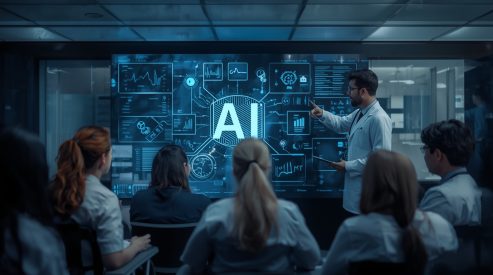
Introduction: The Dawn of a Collaborative Era in Medicine
The integration of artificial intelligence (AI) into the healthcare sector is no longer a futuristic concept but a present-day reality, fundamentally reshaping how patient care is delivered. While early speculation often focused on AI’s potential to replace human medical professionals, the emerging reality is far more collaborative. A new paradigm is taking hold: the human-AI partnership, where AI acts as a powerful co-pilot, augmenting human capabilities rather than simply automating them. By processing vast datasets, identifying complex patterns, and streamlining administrative tasks, AI is empowering doctors, nurses, and researchers to become more efficient, accurate, and focused on the uniquely human aspects of their work—empathy, critical thinking, and patient connection.
This comprehensive analysis delves into the multifaceted role of AI in modern healthcare, exploring its transformative applications across diagnostics, treatment, and operations. We will examine the incredible opportunities for enhanced precision and efficiency, while also confronting the significant challenges that must be addressed for responsible, ethical, and equitable implementation.
The Pillars of AI-Augmented Healthcare
1. Enhancing Diagnostic Accuracy with Machine Learning
One of AI’s most profound impacts is in the field of diagnostics, particularly through the analysis of medical imagery. AI-powered image analysis uses deep learning algorithms to evaluate MRIs, CT scans, X-rays, and ultrasounds with remarkable speed and precision, often identifying subtle patterns that may escape the human eye.
Radiology: AI in Medical Imaging
AI systems assist radiologists by automatically flagging potential abnormalities, such as tumors or fractures. This not only increases diagnostic speed but also reduces the risk of human error, especially in cases where clinicians face overwhelming workloads. AI’s ability to process thousands of images per minute drastically cuts down on the time required for interpretation, freeing up radiologists for more complex cases.
Pathology: AI in Digital Histopathology
In digital pathology, AI-driven histopathological analysis helps identify malignant or pre-cancerous cells in tissue samples. Algorithms can differentiate between healthy and diseased cells with high accuracy, enabling faster and more precise diagnoses, particularly in cancer detection.
Dermatology and Ophthalmology: AI in Screening and Detection
AI-powered tools analyze images of skin lesions to detect conditions like melanoma, often acting as a preliminary screening tool for dermatologists. Similarly, in ophthalmology, AI can analyze retinal scans to detect early signs of diabetic retinopathy, a leading cause of blindness, allowing for earlier intervention.
2. The Rise of Precision and Personalized Medicine
Genomic Analysis and Targeted Therapies
By analyzing a patient’s genetic makeup, AI can help clinicians predict disease progression and select the most effective, targeted therapies. In oncology, for example, AI algorithms can match a patient’s specific tumor biomarkers to the most suitable chemotherapy or immunotherapy regimen, maximizing effectiveness while minimizing adverse side effects.
Optimized Drug Discovery with AI
AI drastically accelerates the pharmaceutical research and development pipeline. Algorithms can screen millions of chemical compounds and simulate their interactions with biological targets, identifying promising drug candidates in a fraction of the time and cost required for traditional methods. Platforms like AlphaFold, which predicts protein structures, are revolutionizing the design of new drugs for complex diseases like Alzheimer’s.
Dynamic Dose Optimization in Treatments
AI platforms, such as CURATE.AI, are being developed to personalize chemotherapy doses based on a patient’s real-time response, optimizing efficacy and mitigating toxicity.
3. Streamlining Operations and Reducing Burnout
AI in Electronic Health Records (EHRs)
AI, specifically natural language processing (NLP), can automate data entry and information retrieval from unstructured clinical notes. It can also summarize medical records, providing clinicians with key patient insights in seconds.
Intelligent Scheduling and Resource Management
AI algorithms can predict patient admission rates, optimize staffing schedules, and manage hospital bed allocations more efficiently. During public health crises, AI has proven invaluable in forecasting patient surges and optimizing the supply chain for medical resources.
Automated Billing and Fraud Detection
AI can significantly improve the accuracy of medical billing and claims processing by automating coding tasks and flagging potential fraudulent activity. This reduces administrative errors and financial losses.
4. Enhancing Patient Engagement and Telemedicine
AI-Powered Chatbots and Virtual Health Assistants
These conversational AI tools provide 24/7 patient support, handling tasks like scheduling appointments, answering common health questions, and sending medication reminders. In some cases, they can perform preliminary symptom assessments, guiding patients to the appropriate level of care.
Remote Patient Monitoring (RPM) with Wearables
AI-powered wearable devices and sensors continuously monitor vital signs, like heart rate and glucose levels, and alert clinicians to potential health risks in real-time. This enables preventative intervention, reduces hospital readmissions, and empowers patients to take a more active role in their own health.
Telemedicine Enhancement through AI
AI is enhancing telemedicine platforms by processing patient information during virtual consultations, enabling remote diagnostics, and improving communication between patients and providers.
The Critical Challenges of AI in Healthcare
1. Ethical Considerations and Algorithmic Bias
Health Equity and Bias in AI Models
An AI model trained predominantly on data from one demographic group may provide less accurate diagnoses for underrepresented populations. This can lead to unequal access to care and poorer health outcomes for marginalized communities. Addressing this requires diverse, high-quality training data and continuous bias audits.
Explainable AI (XAI) and Transparency
Many sophisticated AI models, particularly deep learning networks, are opaque, making it difficult to understand how they arrive at a particular recommendation. For clinicians to trust and responsibly use AI, the technology must be more transparent and explainable.
2. Data Privacy and Security Concerns
PHI Protection and Compliance (HIPAA, GDPR)
Healthcare organizations must comply with strict regulations like HIPAA in the United States and GDPR in Europe. AI systems must use robust security measures, such as strong encryption and secure data storage, to protect this sensitive information from breaches.
Data Anonymization Challenges in Healthcare AI
Properly anonymizing patient data for training AI models is a complex challenge. If anonymization is not done correctly, it could inadvertently expose personal health information. Healthcare institutions must work with vendors who meet stringent privacy and data governance standards.
3. Regulatory and Integration Hurdles
The Need for Clear AI Regulatory Frameworks
Bodies like the FDA are still developing comprehensive guidelines for the approval and oversight of AI-powered software as medical devices. A clear, standardized regulatory framework is necessary to ensure safety and accountability without hindering innovation.
System Interoperability and Legacy Infrastructure
Many healthcare institutions rely on legacy IT infrastructure that may not be compatible with modern AI technologies. Integrating new AI tools into existing EHR systems and clinical workflows requires significant investment and careful planning to ensure seamless operation.
4. The Need for Training and Human Oversight
Digital Literacy for Medical Professionals
The next generation of medical professionals must be trained not only in medicine but also in how to effectively leverage and critically evaluate AI tools. This includes understanding the technology’s capabilities, limitations, and potential for bias.
Continuous Monitoring of AI Models
AI models can drift in performance over time due to changes in patient populations or data inputs. Healthcare providers must establish processes for continuous monitoring and validation to ensure the AI remains accurate and effective in real-world scenarios.
Final Human Decision-Making in Patient Care
In all cases, the final decision and ethical responsibility for patient care must remain with the human clinician. AI should always serve as a tool to inform, not to dictate.
The Future of the Human-AI Healthcare Ecosystem

Towards Proactive, Preventive Medicine
AI’s predictive analytics capabilities will enable a greater focus on preventative medicine. By analyzing genetic data, lifestyle factors, and environmental risks, AI will identify individuals at high risk for diseases, allowing for earlier and more effective interventions.
The Rise of Connected Digital Health Assistants
AI will be increasingly integrated with wearable devices and smart home technology, providing continuous health monitoring and personalized guidance. Patients will have access to powerful, AI-powered health assistants that offer real-time medical advice, medication reminders, and emergency alerts.
Addressing Global Health Inequities with AI
In underserved and rural areas, AI-powered diagnostics and telemedicine can help bridge the gap in access to care. By using mobile applications and portable diagnostic tools, AI can enable remote consultations and early disease detection in resource-constrained regions.

Conclusion: Embracing Augmented Intelligence for a Better Future
The journey of AI in healthcare is just beginning. It is a path marked by extraordinary potential to enhance patient care, increase efficiency, and accelerate medical innovation. The most successful implementation will come not from replacing human expertise with AI, but from fostering a deep and effective human-AI partnership. By proactively addressing the critical challenges of bias, privacy, and regulatory oversight, and by investing in the training of a new generation of digitally-literate healthcare professionals, we can build a more precise, equitable, and ultimately more human-centered healthcare system for all. The co-pilot era is here, and it promises to transform medicine in ways we are only just beginning to imagine.

